Arizona Heat, Matt Stites Edition
When Ian Kennedy was traded to the Padres last summer, the main, known quantity the Diamondbacks received in return was veteran lefty Joe Thatcher. After all, the D-backs at that point were hoping to hang with the Dodgers in the division and were making win-now types of moves. While Thatcher was once again sent packing over the weekend, the other player received in that deal has progressed nicely: Matt Stites.
The quick run-down on Stites is that he’s a short, right-handed power arm who’s a reliever all the way. When Arizona acquired him, he had been tearing up AA for the Padres before an injury ended his season. He didn’t pitch for the Diamondbacks until he opened the 2014 season in AA Mobile, picking right up where he left off. The 24-year old was promoted to AAA Reno after only 12 appearances. Although the PCL is a hitter’s haven, Stites held his own. He struck out 15 batters in 16 innings, walking only five and surrender only 13 hits. On June 19th, he got the call to the majors.
Since being promoted to the big leagues, Stites has flashed some serious heat to go along with a nasty slider. He routinely sits 95-96 with his fastball and can touch 98. The fastball has a lot of movement despite being classified as a four-seamer. It is not a flat offering as it has some serious movement and sink, making it difficult to square up. For comparison’s sake, let’s compare Stites’ four-seamer to Addison Reeds.
Matt Stites Four-Seam Fastball: horizontal and vertical movement
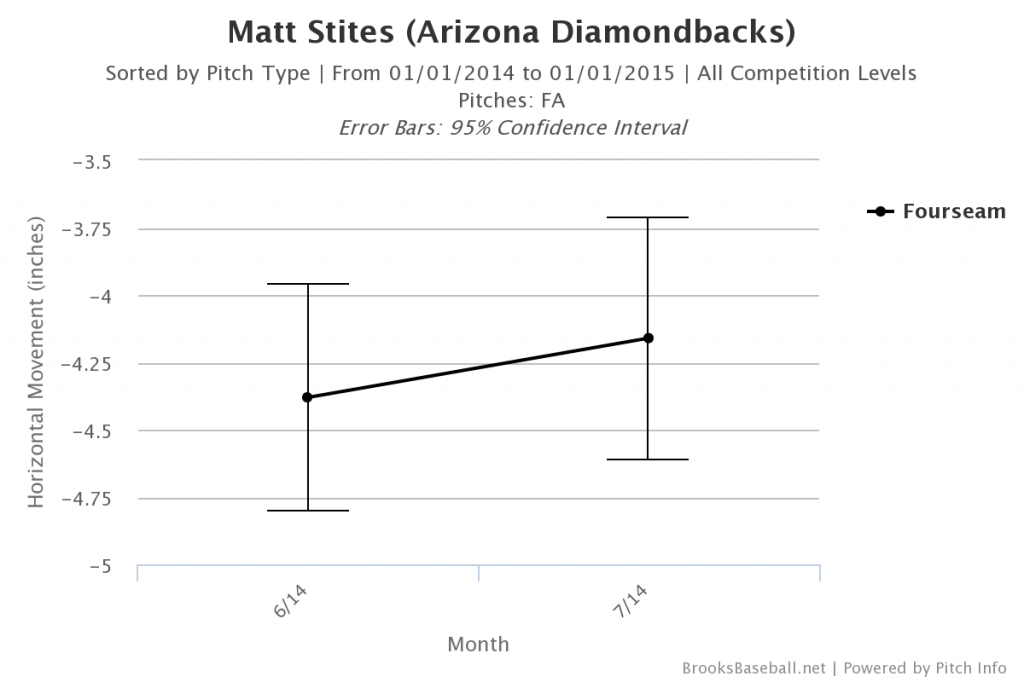
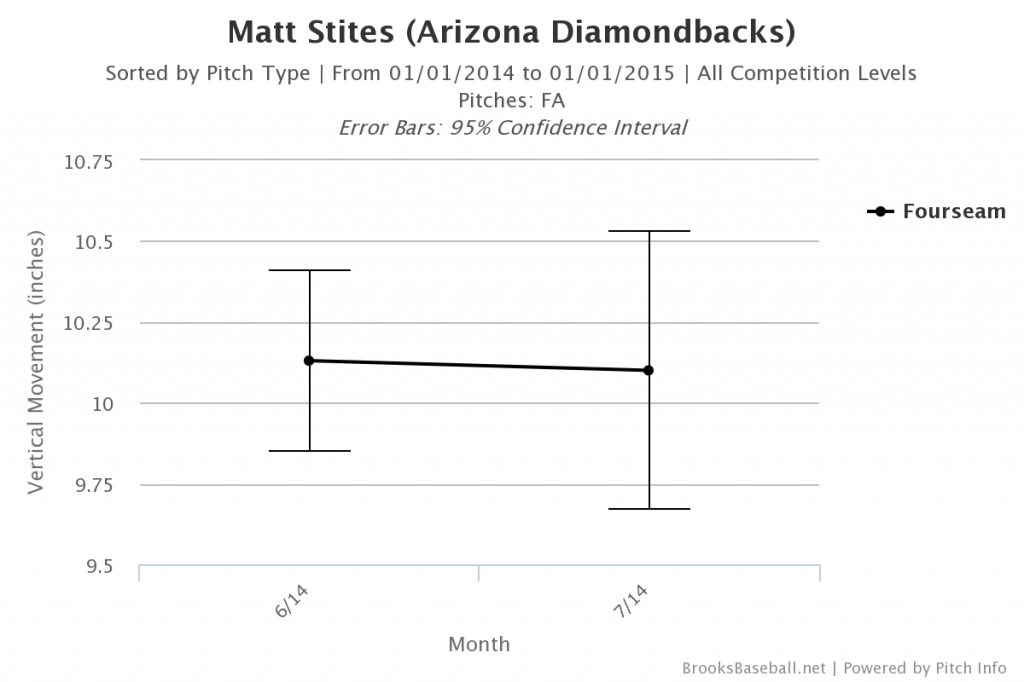 Stites is averaging about 4.25″ of arm-side run on his fastball, breaking in on the hands of righties and away from lefties. He’s also generating over 10″ of sink on the pitch, meaning that as it’s breaking in or away, it’s also fading down in the zone.
Stites is averaging about 4.25″ of arm-side run on his fastball, breaking in on the hands of righties and away from lefties. He’s also generating over 10″ of sink on the pitch, meaning that as it’s breaking in or away, it’s also fading down in the zone.
Addison Reed Four-Seam Fastball: horizontal and vertical movement

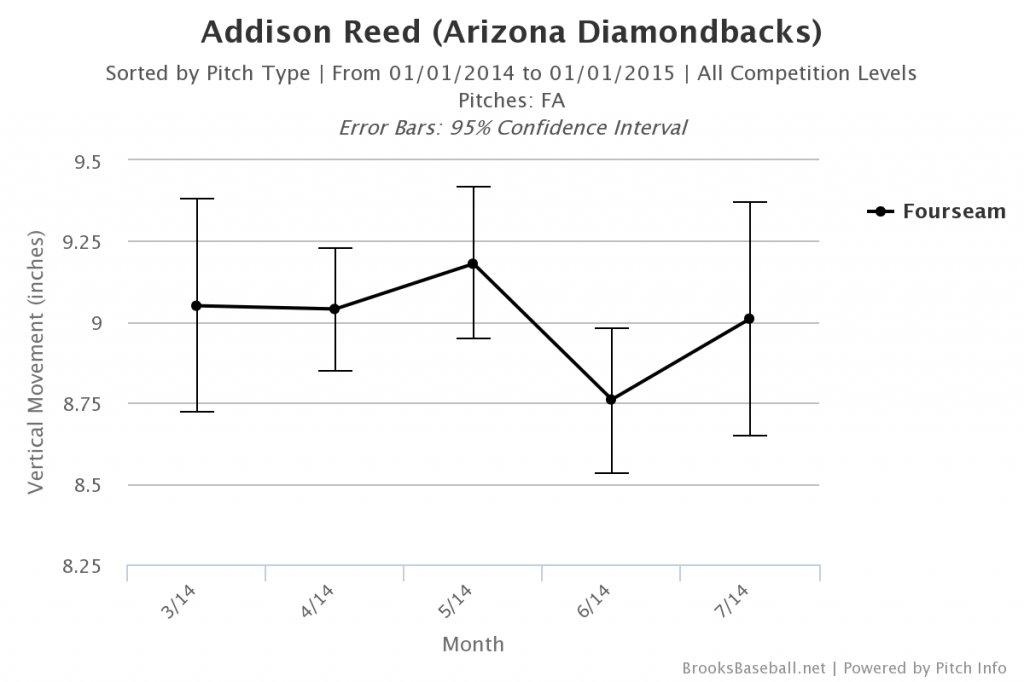 We can see that Reed’s four-seamer’s horizontal movement has varied quite a bit this season, and at present, he’s generating less than 2″ of horizontal run on his heater. In the sink department, he’s sitting right around 9″ of movement.
We can see that Reed’s four-seamer’s horizontal movement has varied quite a bit this season, and at present, he’s generating less than 2″ of horizontal run on his heater. In the sink department, he’s sitting right around 9″ of movement.
Considering that Stites and Reed throw the four-seam fastball with roughly the same frequency (about 70% of the time), it’s easy to see that Stites owns the better heater. It moves more and has the added benefit of 4-5 miles-per-hour of velocity. Combined, this should play in Stites’ favor. But there’s one other factor at play here: location.
If there’s a weakness to Stites’ game at this time, it’s that he has trouble locating. While he’s struck out eight batters over 8.1 innings, he’s also walked five and given up ten hits. Why the trouble? He still struggles to command his pitchers and keep them out of the middle of the zone. For comparison’s sake, let’s check the heat maps of Stites and Reed for all pitches this season.
Matt Stites Heat Map
Addison Reed Heat Map
Comparing the two, we see that despite Reed’s home run problems, he’s doing a better job of keeping the ball down in the zone. It’s a small sample to deal with when it comes to Stites as he’s only thrown 127 major league pitches, but so far, he’s caught the middle part of the zone too frequently. And when he misses, well, big league hitters have a way of doing damage just like Justin Upton did on Saturday. It was Stites’ first home run allowed in the majors and probably a good dose of reality as to what major league hitters can do, even with quality offerings, when they aren’t located properly.
And this could become the bugaboo with Stites. While it’s clearly a small major league sample to work with, even throughout the minors he’s been a fly-ball pitcher. No Diamondbacks fan wants to hear the dreaded-words “fly-ball pitcher,” especially out of the D-backs’ pen. Even with a plus-plus heater and a plus slider, Stites just doesn’t generate a lot of grounders, and if minor league guys weren’t putting the ball on the ground with a high frequency, major league hitters probably won’t either. His changeup is a work in progress and lags behind his other two pitches, but shouldn’t be expected to generate a ton of ground balls as it’s likely to induce some whiffs and pop-ups.
So what is Matt Stites? At this point, it’s probably premature to draw a hard conclusion, but if I had to venture a guess, I’d put him in the mold of David Hernandez: a flamethrower that can strike hitters out and induce a lot of swings-and-misses but is prone to getting hammered when he misses his spots. The movement and velocity on his fastball are nice, but when they aren’t located properly, big league hitters rarely miss. Stites will learn this and his command will sharpen in response. If it does so, look out, because he has the raw stuff to be very effective. As you watch him this season, look for him try to command the bottom of the zone more and don’t be surprised when even 98-mile-per-hour heat gets turned around if it’s up over the plate. They don’t call it The Show for nothing.
4 Responses to Arizona Heat, Matt Stites Edition
Leave a Reply Cancel reply
Recent Posts
@ryanpmorrison
 Congrats to @OutfieldGrass24 on a beautiful life, wedding and wife. He deserves all of it (they both do). And I cou… https://t.co/JzJtQ7TgdJ, Jul 23
Congrats to @OutfieldGrass24 on a beautiful life, wedding and wife. He deserves all of it (they both do). And I cou… https://t.co/JzJtQ7TgdJ, Jul 23 Best part of Peralta’s 108 mph fliner over the fence, IMHO: that he got that much leverage despite scooping it out… https://t.co/ivBrl76adF, Apr 08
Best part of Peralta’s 108 mph fliner over the fence, IMHO: that he got that much leverage despite scooping it out… https://t.co/ivBrl76adF, Apr 08 RT @OutfieldGrass24: If you're bored of watching Patrick Corbin get dudes out, you can check out my latest for @TheAthleticAZ. https://t.co/k1DymgY7zO, Apr 04
RT @OutfieldGrass24: If you're bored of watching Patrick Corbin get dudes out, you can check out my latest for @TheAthleticAZ. https://t.co/k1DymgY7zO, Apr 04 Of course, they may have overtaken the league lead for outs on the bases just now, also...
But in 2017, Arizona ha… https://t.co/38MBrr2D4b, Apr 04
Of course, they may have overtaken the league lead for outs on the bases just now, also...
But in 2017, Arizona ha… https://t.co/38MBrr2D4b, Apr 04 Prior to the games today, there had only been 5 steals of 3rd this season (and no CS) in the National League. The… https://t.co/gVVL84vPQ5, Apr 04
Prior to the games today, there had only been 5 steals of 3rd this season (and no CS) in the National League. The… https://t.co/gVVL84vPQ5, Apr 04
Powered by: Web Designers@outfieldgrass24
 #Dbacks' 2018 1st round pick Matt McLain hit .203/.276/.355 as a freshman at UCLA last year. This season? A tidy li… https://t.co/yM48j1ebrr, 23 hours ago
#Dbacks' 2018 1st round pick Matt McLain hit .203/.276/.355 as a freshman at UCLA last year. This season? A tidy li… https://t.co/yM48j1ebrr, 23 hours ago RT @OutfieldGrass24: Who's that under the radar player who you are banking on to break out this baseball season? Someone who's not regularly in the headlines?, Mar 06
RT @OutfieldGrass24: Who's that under the radar player who you are banking on to break out this baseball season? Someone who's not regularly in the headlines?, Mar 06 Just say "plague" already https://t.co/qkcwY2Omub, Mar 06
Just say "plague" already https://t.co/qkcwY2Omub, Mar 06 RT @wickterrell: You can certainly argue that he already has broken out, but I'm expecting massive things from Ramon Laureano this y… https://t.co/ejJPu9AEnd, Mar 06
RT @wickterrell: You can certainly argue that he already has broken out, but I'm expecting massive things from Ramon Laureano this y… https://t.co/ejJPu9AEnd, Mar 06
Powered by: Web Designers

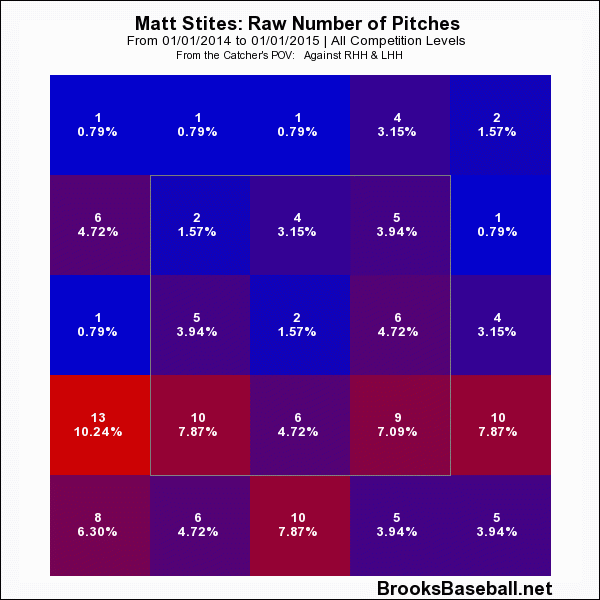
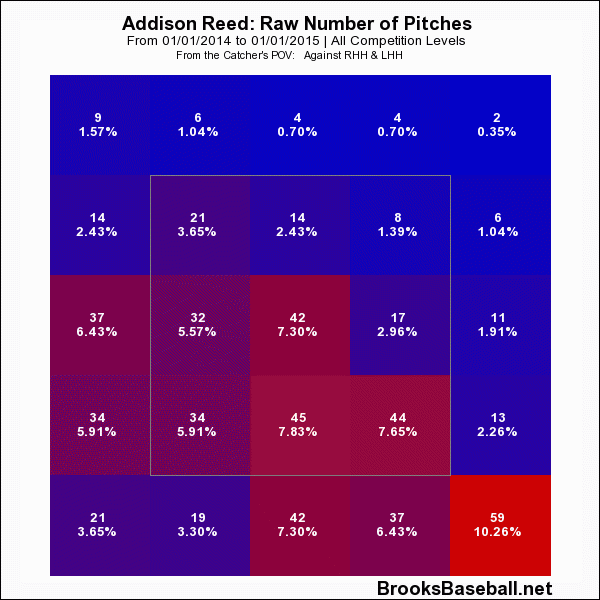




These guys who have superior velocity but lack location control need a circle change and either a curve or a sinker. The ability to drop 10 mph off a 95 mph fastball tends to front foot hitters causing a weakened hit or a miss for a strike. The curve or the sinker vary the plane of the pitch forcing another adjustment to the hitter’s swing. If he can develop these alternatives to the fastball he increases uncertainty for the hitter, making his lack of location less of a vulnerability. Still, it would be best if he can learn to locate his fastball then develop accurate alternatives. There are no short cuts to doing this, just hours of practice.
In all fairness, he does have an excellent slider. I chose to focus my analysis on his fastball since that’s where it all begins for him. But, the slider is an out pitch and he’s used it pretty effectively so far. It will continue to grow in it’s usefulness if improves the fastball command. I’ve seen him hit the low corners with the heat a few times and it’s absolutely nasty. Needs to do it more regularly.
I think Matt Stites is going to be really, really good. I’ve been really impressed with him so far in the big leagues and his stuff is off the charts. Both his fastball and slider have so much movement and he throws them both really hard. His control has been quite bad since reaching the major leagues, but I don’t know why. In his minor league career his BB/9 was only 1.5. That’s excellent, but for some reason, he has just lost his command so far this year. I’m sure it will come back to him though, and I am really excited to see him when it does. I have really high hopes for Matt Stites.
P.S. For goodness sakes, just let Stites close games already. See what he can do in the ninth. I’m so tired of seeing Addison “home run” Reed blow our starting pitcher’s games.
[…] Piecoro also wrote about Matt Stites‘s sudden control issue. I learned a lot from Jeff Wiser’s piece on Stites last week…and I have confidence this will pass. Other cool notes in that notebook, though, […]